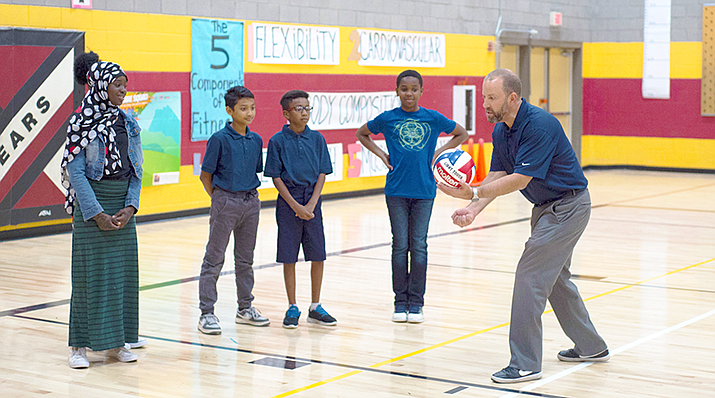With schools shut down, remaining physically active critical to child health
PHOENIX – Doctors have stressed the importance of children remaining physically active in the face of the COVID-19 pandemic, hoping to prevent kids from tumbling down a dangerous, unhealthy path due to the absence of school and structure.
“The important thing that I would push is a schedule, a routine, trying to schedule a bit of exercise to your day,” said Kevin Berger, a pediatrician at Phoenix Pediatrics said. “And also incorporate that exercise into different aspects of your life. Thinking about that exercise, incorporating both mental exercise, healthy habits for your mind and for your body.”
The Centers for Disease Control and Prevention recommends that children ages 6 to 17 do “60 minutes or more of moderate-to-vigorous physical activity daily.”
Kids who participate in regular physical activity are more likely to reduce the risk of developing conditions such as heart disease, cancer, diabetes and obesity, according to the CDC. However, studies show only 24 percent of kids ages 6 to 17 receive at least 60 minutes of physical activity daily.
But with school closed for the remainder of the year, and Arizona under a stay-at-home order, Berger urges parents to keep their children engaged in an active, structured lifestyle – even while stuck at home. He said regular exercise, along with keeping a routine, promotes and teaches children about healthy habits.
“Having that structure in your daily routine is excellent,” he said. “Then, it creates other healthy habits. You’re talking about exercising every day and learning those habits, as well. I think you’re more inclined to eat healthy, as well.
“All around, (exercise) makes kids more aware of what they’re doing and what’s healthy and what’s not.”
Parents may be wrestling with keeping their children structured, whether it be physically, mentally, or during remote classroom sessions. But several organizations, including Jeff Golner’s STEM Sports, have devised creative options.
STEM Sports, a Phoenix-based education company, has made its lessons available for children to continue their education at home – completely free of charge.
STEM, which stands for science, technology, engineering and mathematics, has added a sports component to its lessons. It’s a marriage that Golner believes will keep children engaged and active, despite being away from school.
“We really need to get the kids moving,” Golner said. “Our lessons and our program offers that in some cases. We just thought it was a no-brainer to push our lessons out so there are resources and all the benefits for both the student and the parent.”
Golner has created STEM lessons that pertain to certain sports, like basketball or soccer. With the basketball lesson, children couple the educational aspect of it – learning about the force that goes into dribbling the ball – with physical activity.
“Some (lessons) do provide some physical activity, some don’t,” Golner said. “But, the minds will be kept pretty occupied. They’re doing something they really haven’t done before.”
The CDC says physically active children are also more inclined to perform better in school, which includes having better grades and stronger cognitive performance.
Golner said the free lessons have been widely welcomed by parents across the country, with the program being used in 47 states.
Nearly 2,200 miles away from Golner in Phoenix is Stacy Abbattista, a mother of 8-year-old triplets, in Charleston, South Carolina. The Abbattistas became hooked on the lessons STEM Sports provides after they recently experimented with the soccer module.
“They enjoyed it,” Abbattista, an Arizona State alumna, said. “One of the STEM soccer curriculum is throwing the ball and doing it different ways. They took the trajectory of it, measuring it in centimeters versus meters. They’re getting out there, they’re exercising, they’re running around.
“It’s making them play more, they’re grasping more kinds of concepts, they’re asking us more questions about it. It’s taking playing soccer into a different level, as well. They’re eight, they don’t really think about the math of the game just yet. It gets them thinking that way.”
Abbattista said a majority of her childrens’ at-home education is done through their iPads. She said it’s refreshing to part ways with technology, even if for an hour or two, and learn in a different environment.
Berger said what STEM Sports is offering is “super cool,” but he also pushes parents to incorporate “challenges” amongst friends or family if their kids are dealing with a lack of motivation.
It’s all about getting creative, while mirroring some sort of normalcy, in times like these.
“Let’s get together with friends on Zoom and create a challenge,” he said, referencing an idea he’s seen some parents do. “You get on Zoom, you spend five minutes and everybody goes outside and does something, try to collect as many Easter eggs as they can, for example, come back and count them. You’re incorporating physical activity outdoors and coming back in and doing a little math exercise. Anything that will stimulate that combination of exercise and good habits and learning.
“Having something, an alternative, to go to, is beautiful,” he said. “The weather is perfect right now. Let’s get outside.”
SUBMIT FEEDBACK
Click Below to:




